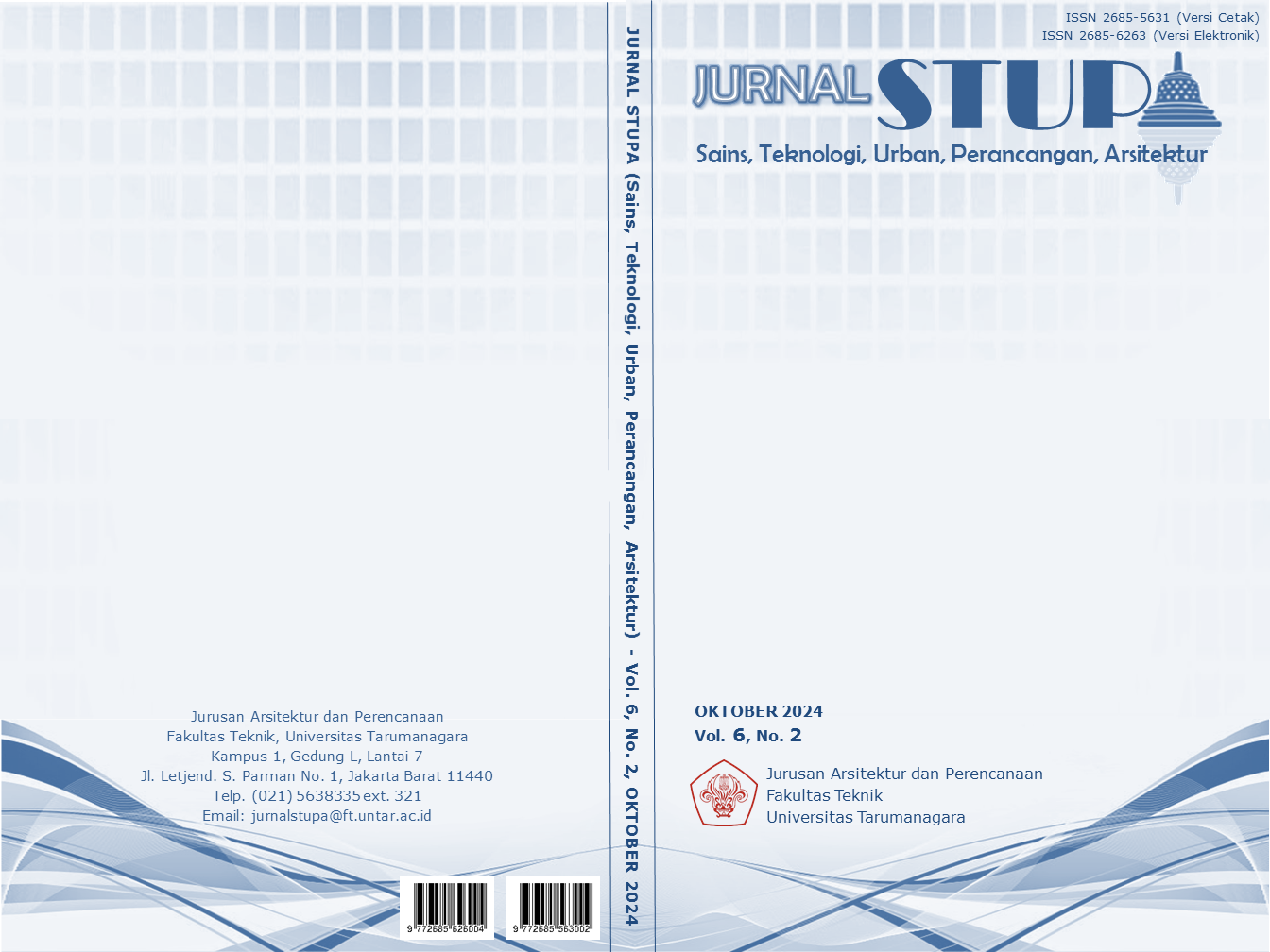PEMBANGUNAN INFRASTRUKTUR DAN PENINGKATAN KUALITAS HIDUP: MENGEMBALIKAN IDENTITAS KAMPUNG KERANG HIJAU MUARA ANGKE
Isi Artikel Utama
Abstrak
Kampung Kerang Hijau, which is part of Kampung Nelayan Muara Angke, is known as the center of Jakarta's green mussel catch, which has become its trademark. However, the village is facing problems that threaten the sustainability of its identity in the current era. This research aims to identify these problems and offer architectural solutions to restore the village's identity. A descriptive qualitative method was used, focusing on the detailed depiction of spatial and building phenomena based on individual experiences. Data was collected through direct observation and interviews with local residents to understand their problems and aspirations. Infrastructure development and improving the quality of life of fishermen in Kampung Kerang Hijau are expected to restore the essence and identity of the village. The architectural solution chosen is expected to overcome the problems faced by this village and strengthen its identity. Thus, it is expected that this village can maintain its existence and cultural uniqueness while adapting to changing times. This research is expected to provide a deeper insight into the problems faced by the village, and offer appropriate solutions to support the sustainability and restoration of the identity of Kampung Kerang Hijau in Muara Angke. The proposed solutions include a residential design on stilts that has connectivity between residences and other public facilities on the second floor so that residents' activities are not hampered when floods hit, village public facilities that support residents' daily activities and needs as well as community socialization, and a green mussel breeding program to improve the quality of green mussel harvests.
Keywords: Identity; Infrastructure; Kerang Hijau Village; People; Placeless Place
Abstrak
Kampung Kerang Hijau, yang merupakan bagian dari Kampung Nelayan Muara Angke, dikenal sebagai pusat hasil tangkapan Kerang Hijau di Jakarta, yang menjadi ciri khasnya. Namun, kampung ini menghadapi masalah yang mengancam keberlangsungan identitasnya pada era saat ini. Penelitian ini bertujuan untuk mengidentifikasi masalah tersebut dan menawarkan solusi arsitektur guna memulihkan identitas kampung. Metode deskriptif kualitatif digunakan, dengan fokus pada penggambaran rinci fenomena ruang dan bangunan berdasarkan pengalaman individu. Untuk memahami permasalahan dan tuntutan warga setempat, pengumpulan data dilakukan melalui observasi langsung dan wawancara terhadap warga setempat. Pengembangan infrastruktur dan peningkatan kualitas hidup nelayan di Kampung Kerang Hijau diharapkan dapat mengembalikan esensi dan identitas kampung. Solusi arsitektural yang dipilih diharapkan dapat mengatasi masalah yang dihadapi kampung ini dan memperkuat jati dirinya. Dengan demikian, diharapkan kampung ini dapat mempertahankan keberadaan dan keunikan budayanya sambil beradaptasi dengan perubahan zaman. Penelitian ini diharapkan memberikan pandangan yang lebih dalam tentang permasalahan yang dihadapi kampung tersebut, serta menawarkan solusi yang tepat guna mendukung keberlangsungan dan pemulihan identitas Kampung Kerang Hijau di Muara Angke. Solusi yang diusulkan antara lain adalah desain hunian panggung yang memiliki konektivitas antar hunian dan fasilitas umum lainnya pada lantai dua agar aktivitas para warga tidak terhambat saat banjir melanda, fasilitas umum kampung yang mendukung aktivitas dan kebutuhan sehari-hari warga juga sosialisasi warga, dan program perkembangbiakan kerang hijau guna menaikkan kualitas hasil panen kerang hijau.
Rincian Artikel

Artikel ini berlisensiCreative Commons Attribution-NonCommercial-ShareAlike 4.0 International License.
This work is licensed under a Jurnal Sains, Teknologi, Urban, Perancangan, Arsitektur/ STUPA Creative Commons Attribution-NonCommercial-ShareAlike 4.0 International LicenseReferensi
Alfian Putra Abdi, E. M. (2023). Nelayan Kecil di Muara Angke: Rakyat Paling Alot Se-Jakarta Mencari Sejahtera Bersama.
Idris, M. (2023, June 9). Profil Pelabuhan Muara Angke: Sejarah dan Fungsinya.
Norberg-Schulz, C. (1980). Genius Loci: Towards a phenomenology of architecture. New York: Rizzoli International Publications.
Rapoport, A. (1990). Culture, architecture, and design. Chicago: The University of Chicago Press.
Relph, E. (1976). Place and Placelessness. London: Pion
Raharjo, W. (2010). Speculative Settlements: Built Form/Tenure Ambiguity in Kampung Development. In: Dissertation, Melbourne of University, Australia Kampung sebagai Model... (Noor/ hal 114-124)
https://journal.uny.ac.id/inersia/article/view/12586/8889
Rural Livelihoods and Cultural Practices in Coastal Villages: A Study of Community Dynamics" (Contoh: Jones, A., & Smith, B. (2017). Rural Livelihoods and Cultural Practices in Coastal Villages: A Study of Community Dynamics. Journal of Rural Studies, 25(2), 145-168.)
Social Interactions and Solidarity in Coastal Communities: Insights from Ethnographic Research" (Contoh: Brown, C., & Williams, D. (2019). Social Interactions and Solidarity in Coastal Communities: Insights from Ethnographic Research. Ethnography and Sociology Journal, 30(3), 310-332.)



